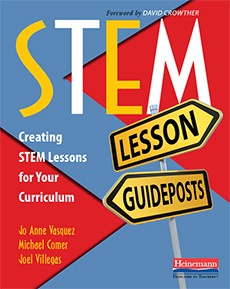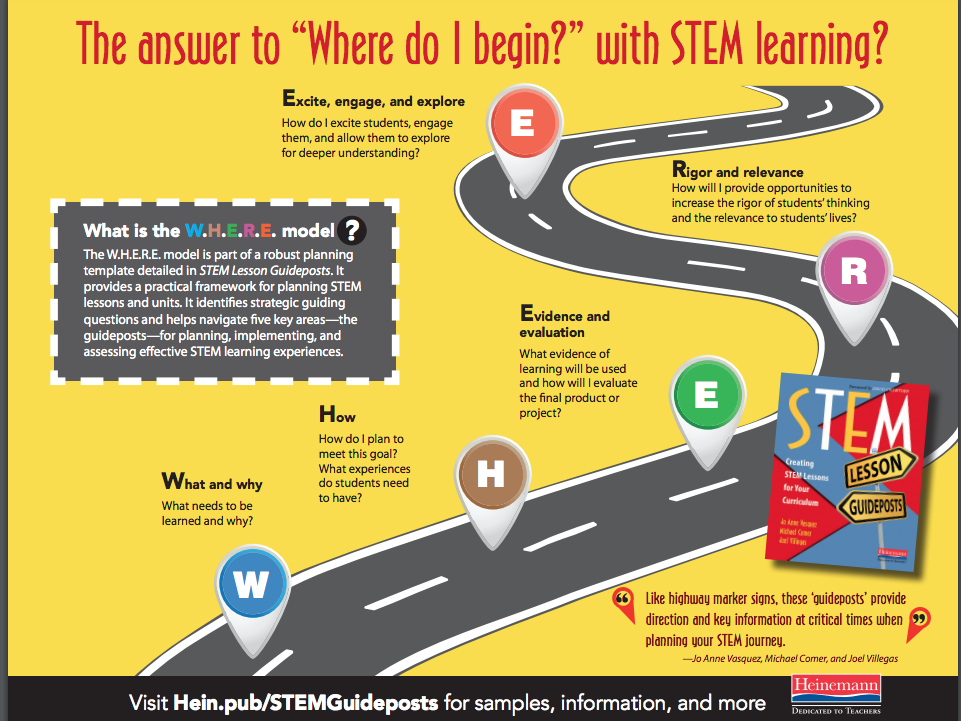STEM Guideposts Help Show the Way
STEM Lesson Guideposts
By Jo Anne Vasquez, Michael Comer, and Joel Villegas
(Heinemann, 2017 – Learn more)

When I think of a “guidepost,” I think of a lighthouse, the light beaming across the ocean, guiding sailors to safe shores. STEM Lesson Guideposts by Jo Anne Vasquez, Michael Comer, and Joel Villegas is that beacon of light, showing the way for teachers as they introduce and integrate STEM lessons into their curriculum.

In the introduction the authors acknowledge the hard work that teachers are doing in the classroom. They also pause to address questions that many teachers have posed:
“How can we create our own STEM units? How do we address the standards we need to cover? How can we create experiences that will engage all students? What does rigor look like in a lesson? How do we begin?” The answer to the last question is “You can begin with this fantastic book.”
The authors launch their book with the W.H.E.R.E. template, an acronym that represents the components of creating an integrated STEM unit.
For those who think that STEM is a new buzzword that will last about as long as some other “trends” in education, I can reassure you that it is not. Interdisciplinary teaching has been around for a long time! This book helps the teacher plan lessons using more hands-on learning and exploring. This book is about teaching students to collaborate, inquire, and think!
Making connections, solving real-world problems
STEM Lesson Guideposts advises the teacher on how to help students make connections to the disciplines they are learning and how to apply what they are learning by designing units that use real-world problems children can solve.
STEM, as defined by Vasquez, Sneider, and Comer, is “an interdisciplinary approach to learning which removes the traditional barriers separating the four disciplines of science, technology, engineering, and mathematics, and integrates them into a real-world, rigorous and relevant learning experience for students.” (Vasquez, Sneider, and Comer, 2013). Notice the new 3Rs: Real-world, rigorous, and relevant.
The book is divided into several distinct sections: STEM practices, the W.H.E.R.E model and lesson template, tips on how to design a lesson using each of the guideposts, a chance for the reader to design their own template for a STEM unit (called the Art Pedestal Project), and how this model is being applied in school districts.
A thorough explanation of each of the W.H.E.R.E. components is discussed in detail by the authors. As they assist your navigation of the book, actual STEM models are shared. Each example has real-world applications such as using an energy unit in the middle school to encourage students to build a wind energy turbine and investigate energy transformations. In short, each unit of study prepares the students to become active citizens of the 21st century, building on the roles they assume of scientists, mathematicians, geographers, and engineers.
Each chapter contains reflective questions called “Speed Bumps” that can be used in a Professional Learning Community, a book club study group, or for self reflection. Whether you are a STEM expert, pre-service teacher, classroom teacher, administrator, or science coach, this book is an exceptional resource.
An approachable, encouraging style
I especially like the way the book is written. It reads like a conversation that you might hear at a professional development workshop, approachable and encouraging. The authors are consistent throughout the book, making sure that their approach to the STEM curriculum is more than a two-dimensional presentation of science, technology, engineering and mathematics. Instead they present a carefully interwoven application of the STEM components and how to seamlessly integrate STEM into the disciplines.
The chapters are written with the busy teacher in mind. There are narratives of specific units that were written and used in the classroom, all of which built on the W.H.E.R.E. model. Each of the lessons, “Engineering a Hat,” “Wind Turbine,” “Feeding Fluffy,” and “Art Pedestal Project,” are detailed in the appendices, which can be used as a model or template.
Final thoughts
This book embraces what best practices in STEM teaching: connecting with authentic experiences, modeling of real-world application, invoking creativity and divergent thinking, and emphasizing the connections between the STEM disciplines.
As a take away, you will want to apply the W.H.E.R, E. model in your classroom repertoire, but you will also have a strong desire to share it with colleagues. The book is about making learning fun, but also making it meaningful and applicable. I would encourage teachers to read the book with colleagues so they can brainstorm together and share the pleasure of high quality support.
As for our students, if we can inspire them to enjoy the STEM curriculum, they will find ways to continue the enjoyment after school, in clubs, and even on their own. The shift towards inquiry will continue. Isn’t that what great teaching is about!
Linda Biondi recently retired as a fourth grade teacher at Sharon Elementary School in Robbinsville, NJ where she was a long-time Morning Meeting practitioner. She is the recipient of several educational grants, a Teacher Consultant with the National Writing Project, and was a participant on the NJ Department of Education Teacher Advisory Panel and with ECET2 Celebrate Teaching. In 2018 she begins supervising student teaching and consulting.
































Thumbs up for this book! I have read others by Vasquez and Comer, and these folks know their stuff. Sounds like a winning approach.